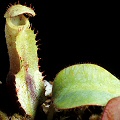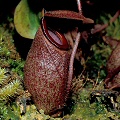Q: Nepenthes: conservation issues
A: The most pressing conservation concern for this genus is habitat destruction, primarily
because of logging practices and agricultural expansion. While a few species actually appreciate disturbance and grow well
in secondary vegetation that grows once climax forests have been cut down, the majority of species do very poorly indeed
when their habitats are logged. Lesser forms of habitat destruction includes the construction of roads, infrastructure, and
housing.
Nepenthes are not adapted to fire, so when their habitats are burned, the
Nepenthes suffer. Fire is often used to clear forest habitats, alas.
Global climate change will have unknown effects on these plants. Extended droughts, for example, will increase
fire threats.
All the species in this genus are on the CITES Appendix II list, except for Nepenthes khasiana and
Nepenthes rajah which are CITES Appendix I. The logic for the membership of this list is not at
all clear to me! A more understandable ranking is given in the ICPS Imperiled Carnivorous Plant Species List.
An example of one of the most threatened species is
Nepenthes clipeata, and the International Carnivorous Plant Society tried to
develope a recovery program to work with horticulturists...but that didn't work out in the end.
Carnivorous plant collectors can have a real role to play in terms of conserving these plants. Expert horticulturists can work
together to ensure that the extremely rare species are well-represented in collections. If such plants were readily available
in horticulture, botanical gardens would have easy access to plants and would not have to encourage plant collection from the wild.
Unfortunately, some carnivorous plant horticulturists engage in plant poaching. Over and over again, we hear of rare plants being
poached from the wild, so limited populations of plants are damaged even further.
What is really pathetic is that, to complete their collections, some horticulturists have stolen herbarium sheets (i.e.
dead specimens from plant museums) of rare species.
There are a number of international sources for Nepenthes, and they offer very rare, interesting
species. It is not always clear their source of propagules, and I have to wonder if, in the whole, they are contributing to
conservation by making plants more available, or contributing to poaching by enhancing interest in the cultivation of plants.
However, I will take this moment to commend the efforts of Robert Cantley (Borneo Exotics) in Sri Lanka
for his exemplary work with Nepenthes horticulture.
Page citations: Cantley, R., et al. 2004; Clarke, C. 1997, 2001;
Hilton-Taylor, C. 2000; Rice, B. 2003c, 2006a; Schlauer, J. 2002; personal observations.

